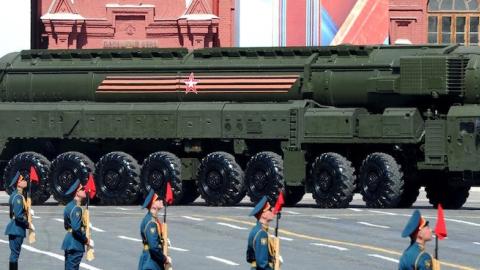The United States and its allies recently celebrated the deployment of a purely defensive system called Aegis Ashore to Deveselu airbase in Romania. The weapons system intercepts medium-range ballistic missiles and is programmed to specifically defend against threats emanating from the Middle East. This is part of the Obama administration’s plan to deploy to Europe various regional (as opposed to homeland defense systems to protect the United States) missile defense systems over a span of several years. The next deployment of an interceptor site will include SM-3 Block IIA Aegis interceptors to Redzikowo, Poland in 2018.
The deployment prompted condemnation from senior Russian officials. Kremlin spokesman, Dmitri S. Peskov, told reporters, “We have been saying right from when this story started that our experts are convinced that the deployment of the ABM system poses a certain threat to the Russian Federation.” A Russian commentator, Konstantin Bogdanov, wrote on a Russian news site that the missile defense sites could lead to Russia’s use of nuclear weapons and that the United States would then finally seek peace with Russia “over the smoking ruins of the East European elements of the missile defense system.” Late last year Vladimir Putin himself said the Russian Federation would respond to U.S.-NATO missile defense deployments by investing in “strike systems capable of penetrating any missile defenses” and would also continue investments in Russia’s own missile defense systems.
Russia has recently changed its military strategy from one that would only allow the employment of nuclear weapons in retaliation to a nuclear attack, to one that allows for the employment of nuclear weapons in a purely non-nuclear (conventional) conflict. The idea is that if Russia were to employ nuclear weapons, rather than retaliating, the United States and NATO might immediately sue for peace, ending the conflict on Russia’s terms, and NATO and the United States would be the clear losers.
The Russians are wrong about this. The United States and NATO have zero tolerance for the use of nuclear weapons and would exact a punishing response against Russian leadership and/or military facilities ensuring there would be no second strike, to put it lightly. At least, this is what the U.S. government should make Waterford-crystal-clear. But even if this administration, by President Obama himself stating it directly to President Putin, were to attempt to disabuse the Russians of the notion that they could successfully “de-escalate” what they perceive as a threat by “escalating,” it would likely be unsuccessful. This is because threats must be credible, not only in reality, but in the minds of those the United States seeks to deter.
U.S. officials might be totally certain that the United States would respond with nuclear force against Russia should Russia miscalculate and employ nuclear weapons. But Russia has to believe this in order for Russian leaders to calculate that employing nuclear weapons is not worth the cost. As we near the close of the second Obama administration term, we should take stock of just how littered with holes U.S. deterrence truly is.
Not only is Russia verbally threatening force against the United States and NATO, it is threatening U.S. ships in international waters, flying nuclear-capable aircraft into NATO, U.S., and Japanese airspace, has invaded and annexed a portion of a sovereign nation—a U.S. ally, is selling the deadly S-300 missiles to terror state Iran (which could provide defense of Iranian nuclear sites), is directly supporting Syria’s Bashir al-Assad militarily, and is violating the Intermediate Nuclear Forces (INF) Treaty. Recall, the INF Treaty banned an entire class of nuclear cruise missiles that are especially destabilizing because they can hold NATO allies at risk at a moment’s notice and with great precision.
The Obama administration, so committed to the ambitious plan of leading the world down the path to zero nuclear weapons, has not made the likelihood of a nuclear exchange less likely. Secretary of State Hillary Clinton’s humiliating and naive attempt at engagement with Russia, which she was confident would lead to a “reset” of U.S.-Russia relations, has resulted in a toxic, highly unstable relationship between Russia and the West.
The United States must seek to regain credible deterrence. Among other things, the U.S. must invest intellectual capital in thinking about how to deter the worse kinds of war in today’s complex global environment. There has been a dearth in serious thought about modern deterrence inside the Pentagon and the White House since the Cold War. Second, the United States must continue to modernize all three legs of the nuclear triad and abstain from signing onto treaties that would limit future U.S. presidents from making decisions about employment, use, and testing of nuclear weapons. Third, the United States must continue to expand missile defense both at home and abroad. The current missile defense policy of the United States is to build only limited missile defense systems to defend against the kinds of missile threats posed by “rogue” nations like Iran and North Korea. But those countries are improving their capabilities, closing the gap between “limited” threats and “complex” threats. Additionally, because the United States has intentionally remained vulnerable to Russian and Chinese missiles, rather than preventing those near-peer competitors from investing in greater offensive capabilities, Russia and China have been assiduously working to exploit U.S. capability gaps and vulnerabilities.
Reversing course and regaining credibility with Russia will be enormously challenging, but one thing is clear: another U.S. Presidential term similar to the previous two could result in the unthinkable.


















